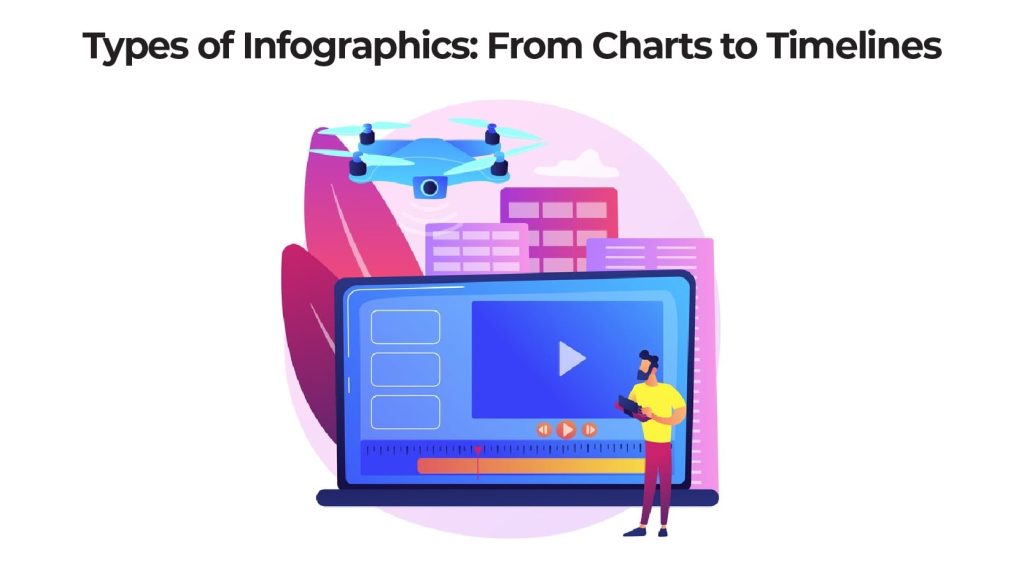Why Are Infographics Important: The Power of Visual Communication
Infographics are highly shareable pieces of content that boost engagement. Dating back over 5,000 years to ancient Egypt, where hieroglyphics and cave paintings served as early examples, infographics have consistently played a vital role in communication. In an era of shorter attention spans, these eye-catching visual representations provide an excellent opportunity for brands to increase their online visibility and connect with their target audience on various social media platforms. Businesses can reinforce their visual identity by incorporating brand elements or logos into infographics while interactively delivering valuable information. In this article, we will explore Why are infographics important? Explore why they have become a staple in modern communication strategies and benefits.
The Power of Visual Communication
Visual communication is a universal language that transcends borders and cultures. It’s the art of conveying information through images, graphics, and other visual elements rather than relying solely on words. In a world inundated with information, visual communication stands out as an effective way to capture attention and communicate complex ideas.
Humans are inherently drawn to visual content. Our brains are wired to process visual information rapidly and efficiently. In fact, about 90% of the information transmitted to our brains is visual. This preference for visuals is deeply rooted in our evolutionary history, where our ancestors relied on visual cues to identify threats, locate food sources, and navigate their environments.
Visuals have a profound impact on how information is received and retained. When we encounter text alone, we might remember only about 10% of it three days later. However, when relevant visuals accompany the text, retention increases significantly to around 65%. This illustrates the power of visuals in enhancing comprehension and memory retention, making them a potent tool for conveying information effectively.
In an increasingly digital and fast-paced world, visual communication has become important and essential. It engages, educates, and persuades, making complex data more digestible and ideas more compelling.

What Are Infographics?
Infographics, short for “information graphics,” are visual representations of data, information, or knowledge. They are designed to make complex information more understandable and accessible to a wide audience. Unlike lengthy reports or data tables, infographics use a combination of text, images, icons, and graphics to convey information concisely and effectively.
One of the primary roles of infographics is to simplify complex data. They transform raw data into visual narratives, allowing viewers to grasp the key insights and trends at a glance. This simplification is especially valuable in fields like data analysis, where massive datasets can be overwhelming without proper visualization. By using charts, graphs, and visual metaphors, infographics distill intricate information into digestible chunks, making it easier for people to comprehend and remember.

The Historical Development and Evolution of Infographics
The history of infographics dates back centuries, with early examples found in ancient cave paintings, Egyptian hieroglyphs, and medieval maps. However, the term “infographic,” as we know it, gained prominence in the 20th century with the rise of print media and graphic design. Pioneers like Otto Neurath and Harry Beck contributed to the development of infographics in the early 1900s, creating iconic designs like the London Underground map.
The digital age has significantly accelerated the evolution of infographics. With the advent of computers and design software, infographics became more accessible and versatile. The internet and social media platforms further propelled their popularity, enabling the rapid dissemination of visual information to a global audience.
Today, infographics continue to evolve, incorporating interactive elements, animations, and dynamic data visualization. They are no longer confined to print media but are vital to online content, marketing materials, educational resources, and data-driven storytelling.
How Infographics Are Revolutionizing Marketing Strategies
Infographics have become an essential tool in the digital marketing world, revolutionizing how brands communicate with their target audience. With their visually appealing blend of images, charts, and text, infographics effectively convey complex information in a concise and engaging manner. This visual storytelling approach helps capture the attention of users bombarded with vast amounts of content daily.
One key advantage of using infographics is their shareability on social media platforms. Due to their eye-catching nature and ability to condense information into easily digestible snippets, infographics are highly likely to be shared by users across various networks. This increases brand visibility and drives traffic back to the website or landing page where the infographic was originally posted.
Moreover, infographics can help establish a brand’s credibility and authority within its industry. By presenting data and expertise in a visually appealing format, companies can position themselves as thought leaders while building trust with their target audience. Additionally, as visuals are processed faster than text by our brains, infographics allow for quick comprehension and retention of information – making them an effective tool for conveying complex subjects or statistics.
Benefits of Using Infographics
Infographics offer several distinct advantages when it comes to communicating information effectively:
1. Enhancing Comprehension: Infographics are designed to simplify complex information, making it more accessible to a broader audience. Combining text with visuals can clarify intricate concepts, making it easier for viewers to understand and process the presented information.
“In a study conducted by the Nielsen Norman Group, web users were found to read only about 20% of the text on an average web page. However, comprehensibility and engagement improved significantly when the same information was presented as an infographic.”
2. Increasing Engagement: Visual content invariably holds more allure than text alone. People are naturally drawn to images and graphics, and this attraction can hold their attention for longer periods. Infographics provide a visually appealing way to present information, which can result in higher engagement rates, particularly in digital and social media contexts.
“According to data from HubSpot, tweets with images receive 150% more retweets than those without images. This demonstrates the higher engagement potential of visual content, including infographics, on social media platforms.”
Get your Free 30 Minute strategy session with an experienced digital animators
3. Boosting Information Retention: Humans are more likely to remember information presented in a visual format. Studies have shown that retention rates can be significantly higher than text-based information when information is conveyed through images and graphics. This makes infographics effective for ensuring your message sticks with your audience.
Research published in the journal “Learning and Instruction” indicates that when information is presented through visuals, like infographics, learners retain up to 65% more of the information three days after exposure compared to text-only learning materials.
4. Making Data More Shareable: Infographics are highly shareable on digital platforms. They are compact, visually appealing, and convey information succinctly. As a result, people are more inclined to share infographics on social media, in emails, or on websites. This can lead to increased visibility and broader dissemination of your message.
Infographics have been widely used in viral marketing campaigns. For instance, the “Distracted Driving” infographic by OnlineSchools.org was shared over 30,000 times within a week of publication, highlighting the ease with which infographics can be shared and spread across the internet.

Types of Infographics
Infographics come in various forms, each tailored to specific purposes and content. Here are five common types of infographics:
1. Chart Infographics: These employ graphs, charts, and diagrams to visualize data, making it ideal for presenting statistical information, trends, and comparisons. Common chart types include bar charts, pie charts, line graphs, and scatter plots.
2. Statistical Infographics: Focused on data, these infographics use a mix of charts, graphs, and numerical representations to present complex statistics and numerical data clearly and understandably.
3. Timeline Infographics: Timeline infographics display a chronological sequence of events or milestones. They help viewers understand the progression of a story, historical events, project timelines, or the evolution of a topic over time.
4. Process Infographics: Explaining step-by-step procedures or workflows, these infographics offer valuable instructional content, providing clarity on task execution or process understanding. Process infographics often use arrows, icons, and flowcharts to guide the viewer.
5. Comparison Infographics: Comparison infographics highlight the differences and similarities between two or more subjects, products, or options. They are effective for decision-making, product comparisons, and weighing pros and cons.
Wrapping up
Infographics are an essential tool in today’s information-driven world. They allow complex data to be presented in a visually appealing and easily understandable format, making it accessible to a wide audience. Infographics not only grab attention but also help retain information better compared to plain text. They have become integral to marketing strategies, social media campaigns, and educational materials. With the increasing amount of online information, infographics are crucial in cutting through the noise and delivering key messages effectively.
Ready to elevate your communication game? Cloud Animations offers premium infographics services to help you convey your message with impact. Let us assist you in crafting visually striking, informative infographics that convey your message effectively.
Don’t miss the chance to turn your data into a compelling story. Contact us today.





